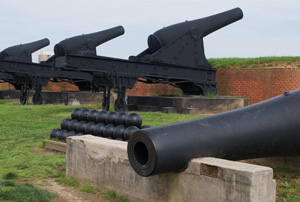
Fort McHenry National Monument and Historic Shrine
Located on Locust Point peninsula in Baltimore (MD) Harbor, Fort McHenry National Monument and Historic Shrine was the site of a key battle in the War of 1812 and the birthplace of our National Anthem. The star-shaped fort survived 25 hours of continuous bombardment from British ships on September 13-14, 1814 – and the sight of its grand 30’ x 42’ American flag still flying at dawn on the 14th inspired Francis Scott Key to write the poem that became The Star-Spangled Banner.
The Baltimore fort is named after James McHenry, secretary of war from 1796-1800 under presidents George Washington and John Adams. The fort has served a variety of roles through its history – as a military prison during the Civil War, U.S. Army hospital during the First World War, and Coast Guard base during the Second World War.
Today, Fort McHenry holds the distinction as the only site in the National Park System designated as both a National Monument and Historic Shrine. Each year, thousands of people visit this “birthplace of our national anthem” – where they enjoy daily ranger talks during the summer, and early 19th century drill, musket and artillery demonstrations by the Fort McHenry Guard on summer weekends. The biggest special event occurs each September, when Defenders’ Day celebrates the successful defense of the city by Fort McHenry in September of 1814.
More information on Fort McHenry National Monument and Historic Shrine.
